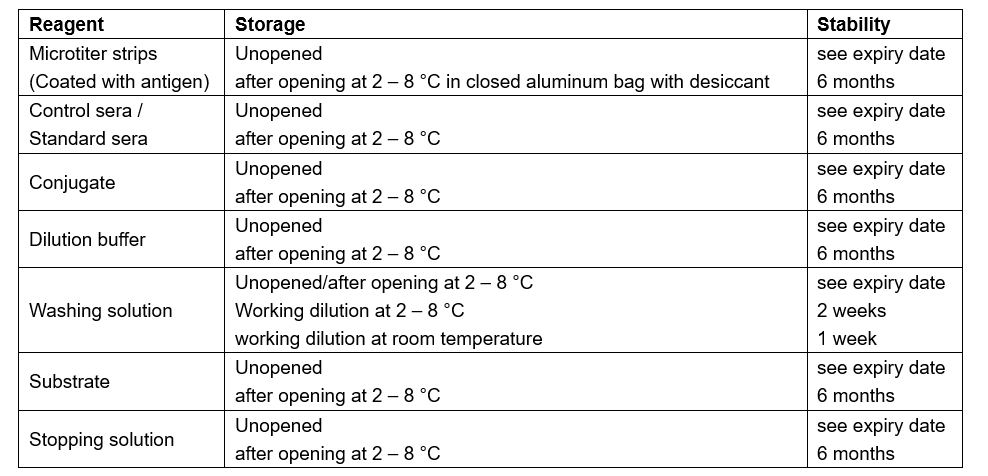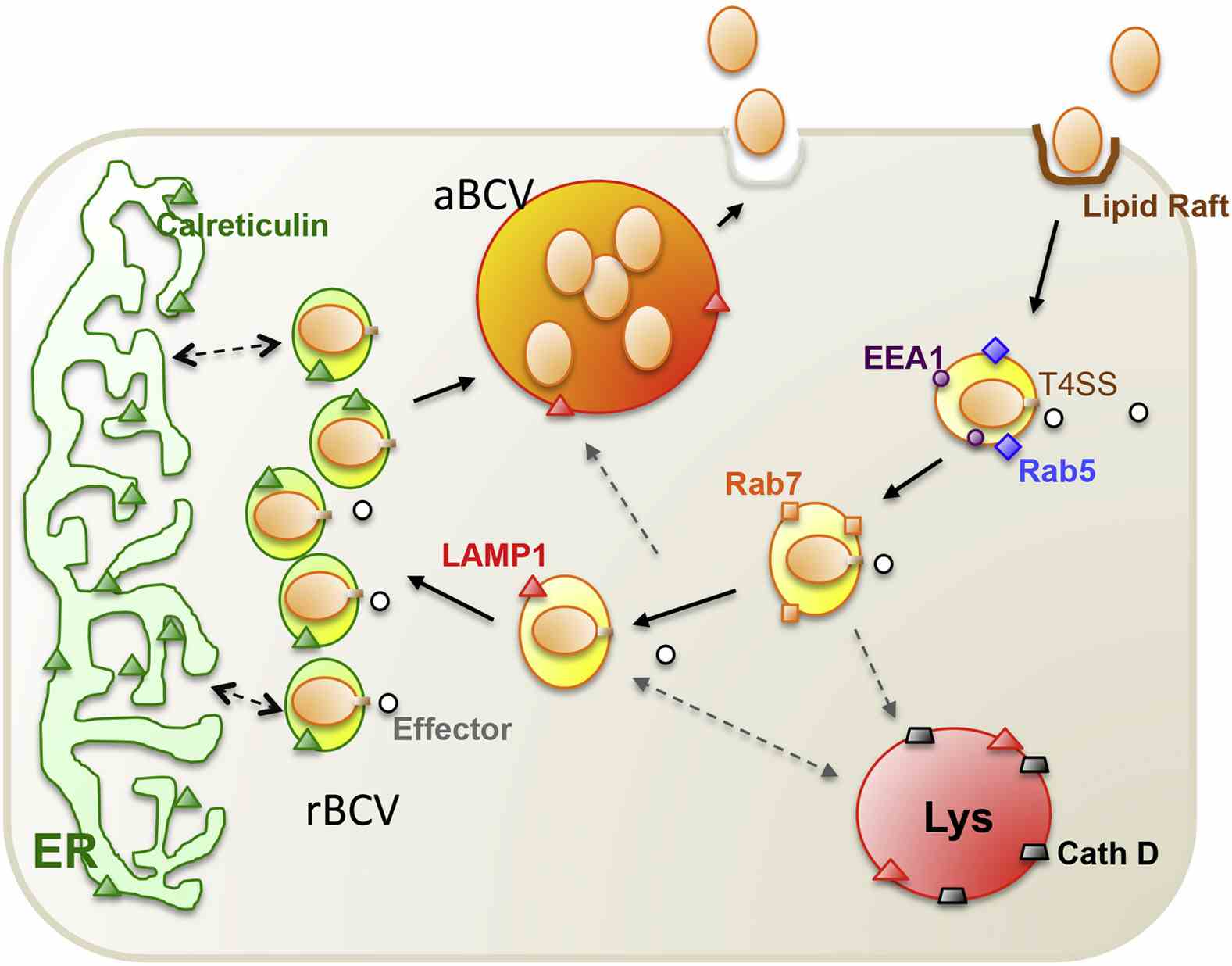Human Brucella IgM ELISA Kit
Regulatory status: For research use only, not for use in diagnostic procedures.
2.Standard serum (ready-to-use) STD Human serum in phosphate buffer with protein; negative for anti-HIV-Ab, HBs-Ag (Hepatitis B-Virus-surface antigen) and anti-HCV-Ab; preservative: < 0.1 % sodium azide, colouring: Amaranth O, 2 x 2 ml
3.Negative control serum (ready-to-use) NEG Human serum in phosphate buffer with protein; negative for anti-HIV-Ab, HBs-Ag (Hepatitis B-Virus-surface antigen) and anti-HCV; preservative: < 0.1 % sodium azide, colouring: Lissamin green V, 2 ml
4.Anti-human-IgM-conjugate (ready-to-use) APC Anti-human-IgM from goat (polyclonal), conjugated to alkaline phosphatase, stabilized with protein stabilization solution, preservative: 0.01 % methylisothiazolone, 0.01 % bromnitrodioxane, 13 ml
5.Washing solution concentrate (sufficient for 1 litre) WASH Sodium chloride solution with Tween 20, 30 mM Tris, preservative: < 0.1 % sodium azide, 33.3 ml
6.Dilution buffer DILB Phosphate buffer with protein and Tween 20; preservative: < 0.1 % sodium azide 0.01 g/l Bromphenol blue sodium salt, 2 x 50 ml
7.Stopping solution STOP 1.2 N sodium hydroxide, 15 ml
8.Substrate (ready-to-use) pNPP Para-nitrophenylphosphate, solvent free buffer, preservative: < 0.1 % sodium azide, (Substrate in unopened bottle may have a slightly yellow coloring. This does not reduce the quality of the product!), 13 ml
9.Quality control certificate with standard curve and evaluation table INFO (quantification of antibodies in IU/ml or U/ml), 1

Accurate diagnosis of Brucellosis most often relies on direct detection of the pathogen or detection of specific antibody response in serum or CSF. Direct pathogen detection in culture systems can be performed with samples of blood, bone marrow, synovial fluid or urine. More rapid results can be obtained with serological methods: agglutination, coombstest, Complement Fixation Test (CFT).
| Product Name | Cat. No. | Applications | Host Species | Datasheet | Price | Add to Basket |
|---|
| Product Name | Cat. No. | Applications | Host Species | Datasheet | Price | Add to Basket |
|---|
Human Brucella is a zoonotic pathogen that causes brucellosis, belonging to the Gram-negative bacteria category. This bacterium has a relatively simple genome, consisting of double-stranded DNA, with a high degree of genetic conservation among different Brucella species. Morphologically, Brucella is a small rod-shaped structure, measuring 0.5 to 0.7 micrometers in width and 0.6 to 1.5 micrometers in length. It is non-motile and does not produce flagella. It grows slowly and requires special media and prolonged incubation under laboratory conditions. One of the unique features of Brucella is its complex cell wall structure, particularly the lipopolysaccharide (LPS) component, which helps it effectively resist the host's immune attacks and provides a basis for infection. After Brucella infection, IgM antibodies are among the earliest antibodies produced. IgM, as the primary response antibody in the immune system, has a large molecular weight and pentameric structure, which effectively binds to antigens and promotes pathogen clearance. During the early stages of Brucella infection, IgM levels rise rapidly, and its detection can be used for early diagnosis.
Brucella infection is typically transmitted through direct contact with infected animals or by consuming contaminated animal products. In humans, brucellosis presents a wide range of symptoms, often manifesting as fever, fatigue, headache, and muscle pain, which are similar to flu-like symptoms, making it easy to confuse with other diseases. In chronic infections, the condition may lead to various complications such as arthritis, hepatosplenomegaly, and neurological damage. Another challenge of brucellosis is its high relapse rate; even with antibiotic treatment, patients may experience recurrence months or years later. The epidemiological characteristics of brucellosis show a global distribution, with higher incidence in areas where animal immunization is inadequate. The transmission routes of Brucella include zoonotic transmission, with livestock such as cattle, sheep, and pigs being the primary hosts and sources of infection. Humans can become infected with Brucella through contact with infected animals or inhalation of contaminated aerosols. Brucella can evade the host's immune surveillance by entering macrophages and surviving long-term within them. The host's immune system responds to infection through both innate and adaptive immunity, with IgM production being one of the early responses. IgM binds to Brucella antigens, helping to activate the complement system and phagocytes, inhibiting bacterial dissemination.
 Figure 1. Intracellular Transport Model of Brucella in Macrophages (Source: de Figueiredo P, et al., 2015)
Figure 1. Intracellular Transport Model of Brucella in Macrophages (Source: de Figueiredo P, et al., 2015)
Brucellosis is difficult to diagnose since its symptoms are similar to those of other diseases, and the bacterium grows slowly. Traditional diagnostic approaches frequently use a combination of techniques. Microbiological culture is the gold standard for verifying Brucella infection; however, due to Brucella's slow development and expensive laboratory requirements, cultures typically take several days to weeks. Blood or tissue cultures are the most straightforward diagnostic methods for identifying the infected Brucella species. In addition to cultures, serological tests are also important for diagnosing brucellosis. Common serological tests include agglutination tests and ELISA (enzyme-linked immunosorbent assay), which detect antibody responses in the serum to confirm infection. However, it is important to note that serological tests may result in false negatives due to low antibody levels or prolonged infection duration. Recently, nucleic acid amplification technologies (e.g., PCR) have also been widely used for the rapid diagnosis of brucellosis. These technologies offer high sensitivity and specificity, allowing for early detection of the pathogen. In terms of prevention and control, managing brucellosis primarily involves controlling infections in animals. Regular screening, vaccination, and culling of infected animals are effective measures to reduce Brucella transmission. In high-risk areas, controlling the circulation of untreated dairy products and enhancing public health education are also important preventive measures. Additionally, for individuals at occupational risk, such as veterinarians and farm workers, protective measures should be implemented to minimize direct contact with infected animals.
Brucella IgM Detection Kit
Human Brucella IgM Test
Brucellosis IgM ELISA Kit
References
1. de Figueiredo P, et al. Pathogenesis and immunobiology of brucellosis: review of Brucella–host interactions. The American Journal of Pathology. 2015;185(6):1505-1517.
Invoice / Purchase Order
Credit card
![]()